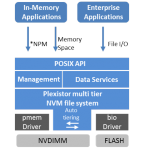I’m really excited about the prospects of memory-addressable flash. Moving flash closer to the CPU and addressing it as memory rather than block storage brings tremendous performance benefits, and is a once-in-a-generation radical change to system architecture. But questions remain as to how it can be integrated with today’s applications. Now Plexistor is here with a promising solution: Their “Software-Defined Memory” concept is a generic filesystem for storage, from NVDIMM to NVMe to SSD.
Maxta
Qumulo Launches To Manage Data At Scale
But what do you do after creating Isilon, the most successful scale-out storage platform in history? Add in some advanced data management services and make it a software-only platform!
Making a Case For (and Against) Software-Defined Storage
Everyone is talking about “software-defined†everything lately, so it was only a matter of time before industry buzz turned to software-defined storage. VMware and EMC really stoked the flames with a constant barrage of marketing directed in this direction. But how exactly do you software-define storage? And what does this mean?


